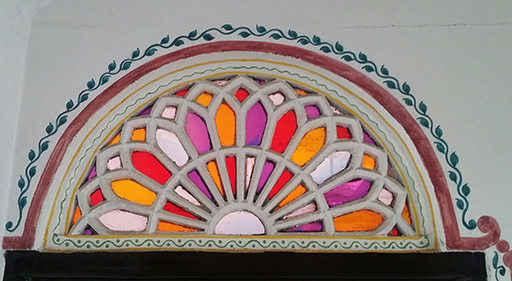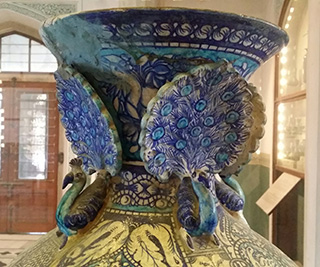

Key points
- The Indian Peafowl, more commonly known as the Peacock, is the National Bird of India
- The peacock is significant in the cultural history of India
- Peacocks can often be seen on visits to Ikaki Bagh as well as in Jaipur City
Indian culture and civilization have had a close co-existence with the natural world. Trees, birds, mammals and reptiles are integral across all religions and belief systems. This co-existence is central to Indians’ exploration of the deeper meanings of life and connection with the earth and the universe.
In 1963, the peacock was adopted as the National Bird of India. It was chosen because of its unique qualities it symbolises. These include its beauty, vivid colour and grace, as well as its cultural significance.
The Peacock and Lord Krishna
The peacock is especially associated with Lord Krishna. Lord Krishna is one of the ten incarnations of Lord Vishnu. Lord Krishna is notable for wearing a crown made of peacock feathers.
A story, from religious history recount an occasion once when Lord Krishna was playing his flute. The nearby peacocks started dancing in joy listening to the sweet tunes of his flute. After the dance they spread their feathers on the ground. The chief peacock then offered the feathers to Lord Krishna with humility. Lord Krishna accepted the gift and adorned himself with them in the form of a crown.
It is believed, that when someone worships Lord Krishna with the feathers on his crown they are blessed with auspiciousness. They are also blessed with wealth, good health and transcendent knowledge. It is believed the feathers protect the worshipper from evil eyes and destroys negativity, such as anger and greed.
The Lord Krishna’s peacock crown inspired one of Jaipur’s finest Rajput historic buildings. The Hawa Mahal (translated in English as the ‘Palace of the Winds’) was built in 1799. The five-storey pyramidal structure signifies the crown of Krishna and the tail of the peacock. These elements assert royalty and power. The façade of Hawa Mahal is enriched with a variety of beautiful peacock inspired ornamentation.
Mughals and the Peacock
The peacock and its feather motifs featured prominently throughout the Mughal era in India.
Shah Jahan is widely considered one of the greatest Mughal emperors and ruled India from 1628 to 1658. He is associated with one of the greatest periods of architecture in India’s history. Most notable is Taj Mahal. This ivory white mausoleum was built in honour of Shah Jahan’s favourite wife, Mumtaz Mahal and was built from 1632 to 1643.
Shah Jahan also commissioned the Peacock Throne. This famous jewelled throne became the seat of the Mughal Emperors in the Hall of Private Audiences in the Red Fort of Delhi.
Contemporary accounts of the Peacock Throne are breathtaking. The throne included stylized elements from the peacock.
It was extravagantly covered in gold and jewels including some of the most magnificent diamonds in the known world.
The throne was the central feature of a court built to be a mirror image of paradise on earth. Sadly, the Peacock Throne was captured in the Persian invasion of Delhi in 1739 and has been lost since.
Equally as stunning is the ‘Peacock Gate’ at the City Palace inside the Old City in Jaipur.
The peacock and peacock feather continued to be a widely popular motif after the decline of the Mughals and the rise of the British Colonial era.
Logos, textile patterns, houseware and fashion all drew inspiration in the British Colonial era from the peacock. The peacock particularly inspired a variety of stylized interior designs. One of the most striking and popular forms used coloured glass inlaid above door portals and the like.
Characteristics of the Peacock
It is the male of the species that presents the distinctive, striking beauty. They most vigorously display their extravagant tails during courtship. Males can grow to a length of 195 to 225 cm from tip of the beak to the end of the train and weigh an average of 5 Kg.
By contrast the female (often called a peahen or peafowl) is much plainer. Their feathers are most commonly grey, brown or cream. This provides much them with much better camouflage than the males in the wild.
The peacock has adapted to all the weather conditions. They can live in dry and hot deserts, and even in quite cold conditions. Peacocks generally live in jungle, or open forest where there are trees or large bushes for sleep at night.
Peacocks also prefer near a water source. They love rain and will often open their feathers and dance. These moves are also considered a sign that rain is coming.
The call of a peacock is a distinctive, sharp and very shrill call. They typically crow in the morning and evening.
Both males and females are noted for being exceptionally alert. In the wild, they will often be the first to single danger to other birds.
Peacocks are also well-suited to farm and domestic habitation. They are very adaptable feeders. Their sharp senses mean they can be easily trained to perform a similar role to a guard dog and to raise the alarm.
Peacocks and Ikaki Bagh
Peacocks can be seen in the secluded forests surrounding Jaipur. Areas include:
- the open woodlands on the way to the unique Hindu historic site of Hanuman Ji Temple (commonly called, ‘The Monkey Temple’,
- Jhalana Forest Reserve, and
- The countryside surrounding Narhargah Fort on the edge of the Aravalli Hills.
Visitors to Ikaki Bagh often come across wild peacocks that live in remanent woodland. One of the most spectacular sights is seeing a peacock in flight.
Peacocks visiting Ikaki Bagh mostly feed on what is available locally. We do provide supplementary feed being careful not to give them anything incompatible with their dietary norms.
Our tree planting program focuses on indigenous species that promote ecological diversity. This includes species such as gullar which produces fruits favoured by peacocks.
It is illegal to keep peacocks as pets in India. However, people do feed birds and look out for their welfare. So respected is the peacock, that it is unlikely you will see a bird in captivity.
There are opportunities to see free roaming, semi-domesticated peacocks in Jaipur City. Birds live in some of Jaipur’s city parks.
There is even a Peacock Rooftop Restaurant in central Jaipur. This highly regarded restaurant is popular with tourists and visitors alike.


